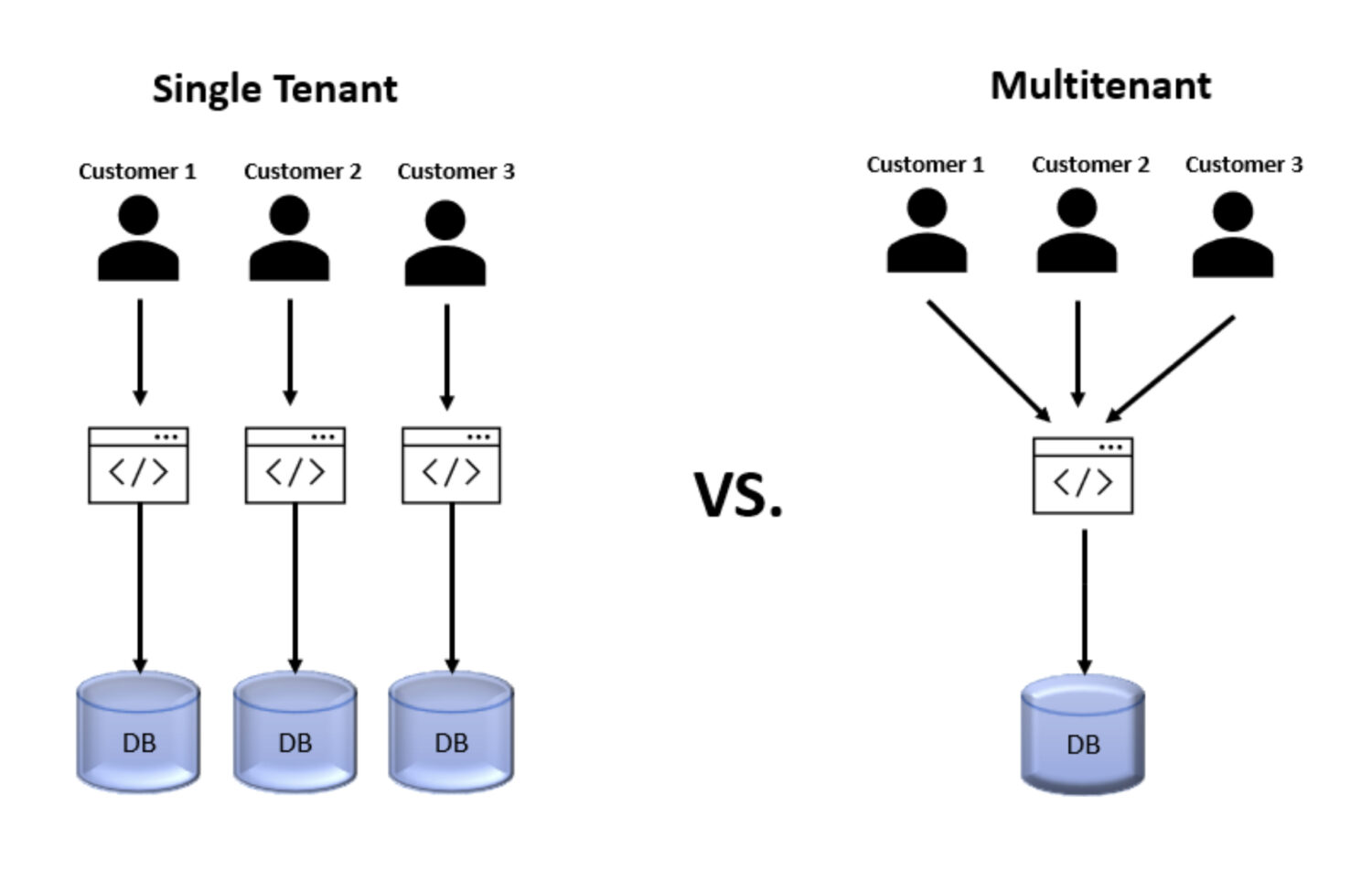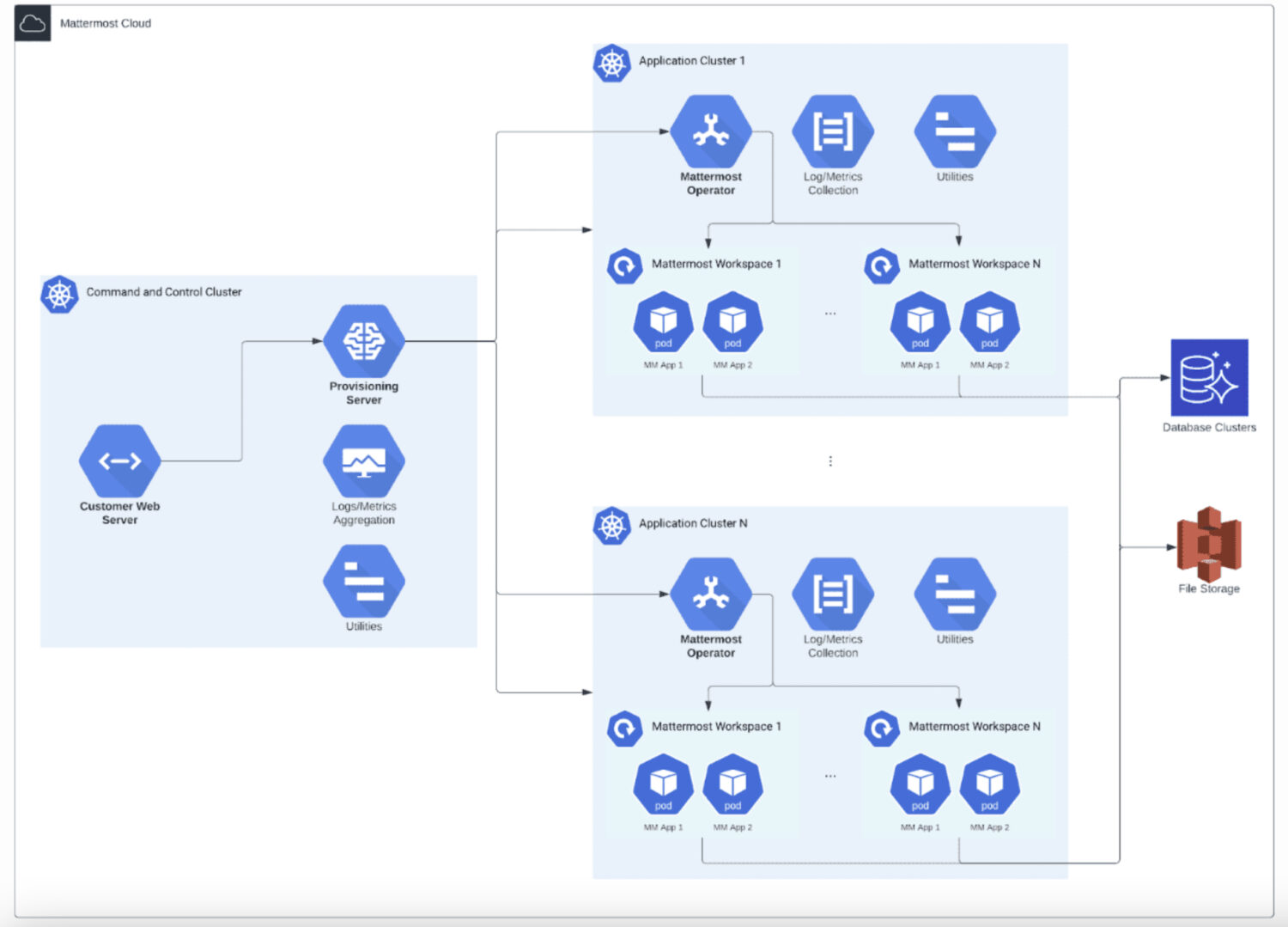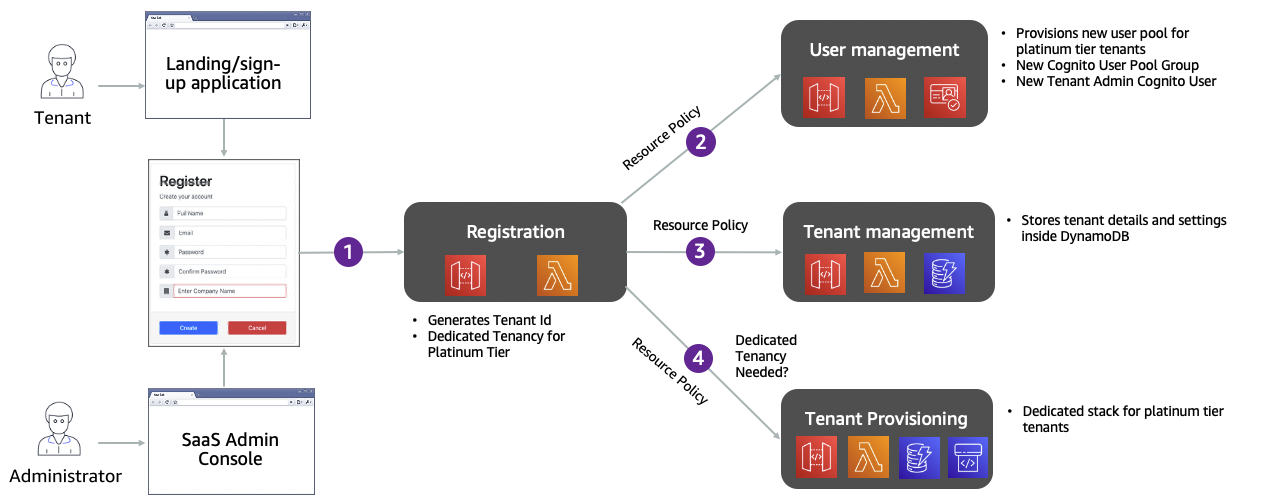In cloud computing, the term tenant represents a group or an individual user who has access to a shared pool of computing resources, such as storage, servers, and applications. The resources are provided by a cloud service provider.
Each tenant is isolated from other tenants, and they cannot access each other’s data or resources. Multiple tenants can share the same infrastructure while maintaining their own privacy and security. Tenants can be individuals, organizations, or departments within an organization.
If the resources and infrastructure are dedicated to only one tenant, then we call such architecture a single tenant. If multiple different tenants share the same resources, this represents multi-tenant architecture.
However, the difference between single tenant and multi-tenant architecture is slightly more tricky. For example, you can use AWS as a cloud services provider to set up single tenant architecture as well as multi-tenant architecture. The difference lies in the details. Here they are.

Now, let’s explore the summary of both architectures before going into details.
| Feature | Single Tenant Architecture | Multi-Tenant Architecture |
|---|---|---|
| Resources Sharing | Not shared with others | Shared among multiple customers |
| Customization | Highly customizable | Limited customization |
| Cost | Generally more expensive | Generally less expensive |
| Security | Enhanced security | Lower security level |
| Performance | Predictable performance | Scalability impact |
| Maintenance | Customer maintains resources | Cloud provider handles maintenance |
| Collaboration | Limited collaboration | Greater collaboration |
| Compliance | Better compliance with specific regulations | Standard processes for all tenants |
Single Tenant Architecture
Single tenant cloud applications are designed to serve a single customer or organization and provide dedicated resources that are not shared with other customers.

It is a model where a single customer or tenant has exclusive access to a server, application, or infrastructure in the cloud. In this model, the customer has complete control over the resources and can customize them to meet their specific needs. This means that the cloud resources are dedicated to that customer.
This single tenant can customize the resources to meet specific needs. This means greater flexibility and control over the resources.
It is generally more expensive than multi-tenant architecture since the customer alone is paying for dedicated resources.
Here’s an example of how you can build an end-to-end single tenant architecture in the AWS cloud:
- Create a Virtual Private Network (VPC) to isolate the resources of the single tenant. The VPC will provide network isolation and security.
- Use Identity and Access Management (IAM) to manage access to resources for the single tenant. IAM creates policies that define what resources the tenant can access.
- Use Elastic Compute Cloud (EC2) to provision virtual machines for a single tenant. EC2 creates instances with specific configurations and provides complete control over the resources.
- Use Elastic Block Store (EBS) to provide block-level storage for the virtual machines.
- Use Relational Database Service (RDS) to provide a managed database service for the single tenant. You can create a separate database instance for the tenant, which provides isolation and security.
- Use Amazon S3 to store static assets such as images, videos, and documents. You can create a separate bucket for the tenant, which only the tenant can access.
- Use Elastic Load Balancer (ELB) to distribute traffic across multiple instances of your application, all inside the resources dedicated to your tenant only.
Examples of Cloud Applications
Here are some of the most known cloud applications that you can use for single tenant architecture.
- Workday is a cloud-based human resources and financial management software that provides a single tenant architecture to its customers.
- SAP HANA cloud-based platform.
- Oracle Cloud architecture.
- IBM Cloud Dedicated with dedicated resources to be not shared with other customers.
- Rackspace Private Cloud.
Advantages of Single Tenant Cloud Architecture
Single tenant cloud architecture has some advantages over multi-tenant architecture:
- Enhanced security since the resources are dedicated to a single customer. The customer has complete control over the security of their resources. It eliminates the risk of data leakage or unauthorized access that can potentially occur in multi-tenant environments.
- Greater customization is another advantage. You can customize the resources to meet their specific needs, resulting in better performance and efficiency. You also have greater flexibility in terms of software and hardware choices.
- Predictable performance since the resources are dedicated to a single customer. You can expect consistent performance loads, which is important for applications that require high levels of performance and reliability.
- Better compliance with specific regulations or standards as the resources are only for one tenant.
- Greater scalability since the customer can scale resources up or down as needed.
However, single tenant architecture is generally more expensive than multi-tenant architecture, so it’s definitely not the best choice for all organizations.
Real-World Use Cases of Single Tenant Cloud Architecture
Here are some of the best use cases for single tenant architecture:
- Healthcare organizations are required to comply with strict regulations such as HIPAA, which require high levels of security and privacy. The single tenant architecture enables healthcare organizations to have complete control over their resources and implement security measures specific to the needs of patients and staff.
- Financial organizations are required to comply with strict regulations such as PCI DSS. Single tenant architecture is, therefore, a good solution.
- Government organizations must comply with strict regulations such as FISMA, which again require high levels of security and compliance.
- Research organizations often require high levels of customization and performance for their resources.
- E-commerce organizations are another use case for single tenant architecture. You can scale their resources up or down as needed to meet the changing needs of their customers.
Multi-Tenant Architecture

Multi-tenant architecture is often the best solution for organizations prioritizing cost savings, scalability, and collaboration above high security and customization needs.
- Multiple customers share the same resources in the cloud. This means the resources are not dedicated to any customer and are shared among all customers.
- Multi-tenant architecture is generally less expensive than single tenant architecture simply due to the nature of shared resources.
- There are limits to how much customization can be done. This can be a disadvantage for customers who require highly customized resources.
Here’s an example of how you can build an end-to-end multi-tenant architecture in the AWS cloud:
- Create a VPC to isolate the resources of each tenant. Each tenant will have their own VPC, providing network isolation and security.
- Use IAM to manage access to resources for each tenant. IAM defines policies and what resources each tenant can access. It can be different policies for each tenant.
- Use ELB to distribute traffic across multiple instances of your application. Control which traffic goes to which tenant.
- Use RDS to provide a managed database service for each tenant. Create separate database instances for each tenant, with separate database privileges and data content. You can use the same database cluster. This gives the tenants isolation and security.
- Use Amazon S3 to store static assets such as images, videos, and documents. You can control the accesses to the buckets for the tenants. You can have it shared between multiple accounts or separated if needed.
- Use CloudFront to distribute static assets to users. Create separate distributions for each tenant, which gives isolation and security.
Examples of Cloud Applications
Here are some real-world examples of multi-tenant cloud applications:
- Salesforce is a cloud-based customer relationship management (CRM) platform that enables multiple organizations to use the same infrastructure while keeping their data separate and secure.
- Dropbox is a cloud-based file storage and sharing service that allows multiple users to collaborate on the same files.
- Microsoft Office 365 is a cloud-based productivity suite that allows multiple users to collaborate on the same documents, spreadsheets, and presentations.
- Google Workspace is another cloud-based productivity suite similar to the one from Microsoft.
- AWS is a cloud-based infrastructure platform that allows multiple organizations to use the same infrastructure while keeping their data separate and secure.
Advantages of Multi-Tenant Architecture
Multi-tenant cloud architecture has some specific advantages:
- This architecture is generally less expensive than single -tenant architecture. Multiple customers share the resources.
- It has a greater scalability impact. Resources scale up or down as needed to meet the changing needs of the customers as they share the resources together. It will scale for all of them at the same time.
- This architecture requires less maintenance. The cloud provider is responsible for maintaining the resources, which are the same for all tenants. So you do the maintenance only once.
- You have greater collaboration among customers since they are sharing the same resources. Customers can work together on projects and share data more efficiently.
- This architecture promotes standardization. The cloud provider can implement standard processes and procedures and apply them to all tenants simultaneously.
However, multi-tenant architecture may not be the best choice if organizations require high levels of security, compliance, or customization. Shared resources are lowering the opportunities for all of those.
Real-World Use Cases of Multi-Tenant Architecture
Here are some of the best use cases for multi-tenant architecture:
- Small and Medium-sized Businesses (SMBs) often have limited budgets and resources, which makes multi-tenant architecture an attractive option.
- Software as a Service (SaaS) providers use multi-tenant architecture to provide services to multiple customers.
- Social media platforms require high levels of scalability and collaboration. The multi-tenant architecture enables social media platforms to scale their resources up or down as needed to meet the changing needs of their users.
- Educational institutions often require cost-effective solutions for their IT infrastructure. The multi-tenant architecture enables educational institutions to share the cost of resources with other institutions, resulting in cost savings.
- Public cloud providers use multi-tenant architecture to provide their services to multiple customers.
Where Does AWS Cloud Fit?

As stated above, you can set up AWS as a single as well as multi-tenant architecture.
You can create dedicated infrastructure for a single customer or organization. For example, AWS has EC2 Dedicated Hosts, which provide physical servers that are dedicated to a single customer. This allows the customer to have complete control over the underlying hardware.
AWS also has Virtual Private Cloud (VPC), which allows customers to create isolated virtual networks within the AWS cloud.
But AWS can provide a range of services that you can use to create shared infrastructure. For example, AWS offers EC2 instances (not dedicated), which provide virtual servers that can be shared by multiple customers. Then you share the same underlying hardware and infrastructure while maintaining their own privacy and security.
Or you can use services such as Amazon S3, which enables you to share the same storage between multiple customers. Customers can store and retrieve data in a shared environment.
When it comes to RDS databases in AWS, you have again options to set them up in various ways. You might create separate database instances for each tenant. You can also create a dedicated database cluster and instance for the single tenant.
Finally, you can use RDS to create a shared database service for multiple tenants. Then such database instance supports multiple tenants, and it ultimately limits its level of customization or performance.
This means it’s not the platform that determines whether you will have single or multi-tenant architecture. It’s much more about how you configure and set up the platform.
Final Words
The choice between single tenant and multi-tenant architecture depends on the specific needs of the customer. Single tenant architecture generally prefers those organizations that require high levels of security, compliance, and customization. Multi-tenant architecture prefers organizations that prioritize cost savings and scalability.
Cloud platforms like, for example, AWS offer you the possibility to change your mind over the course of time. You can also use them to create a hybrid environment where each case will have its own place and work together well.
Next, check out multitenancy in cloud computing explained.

